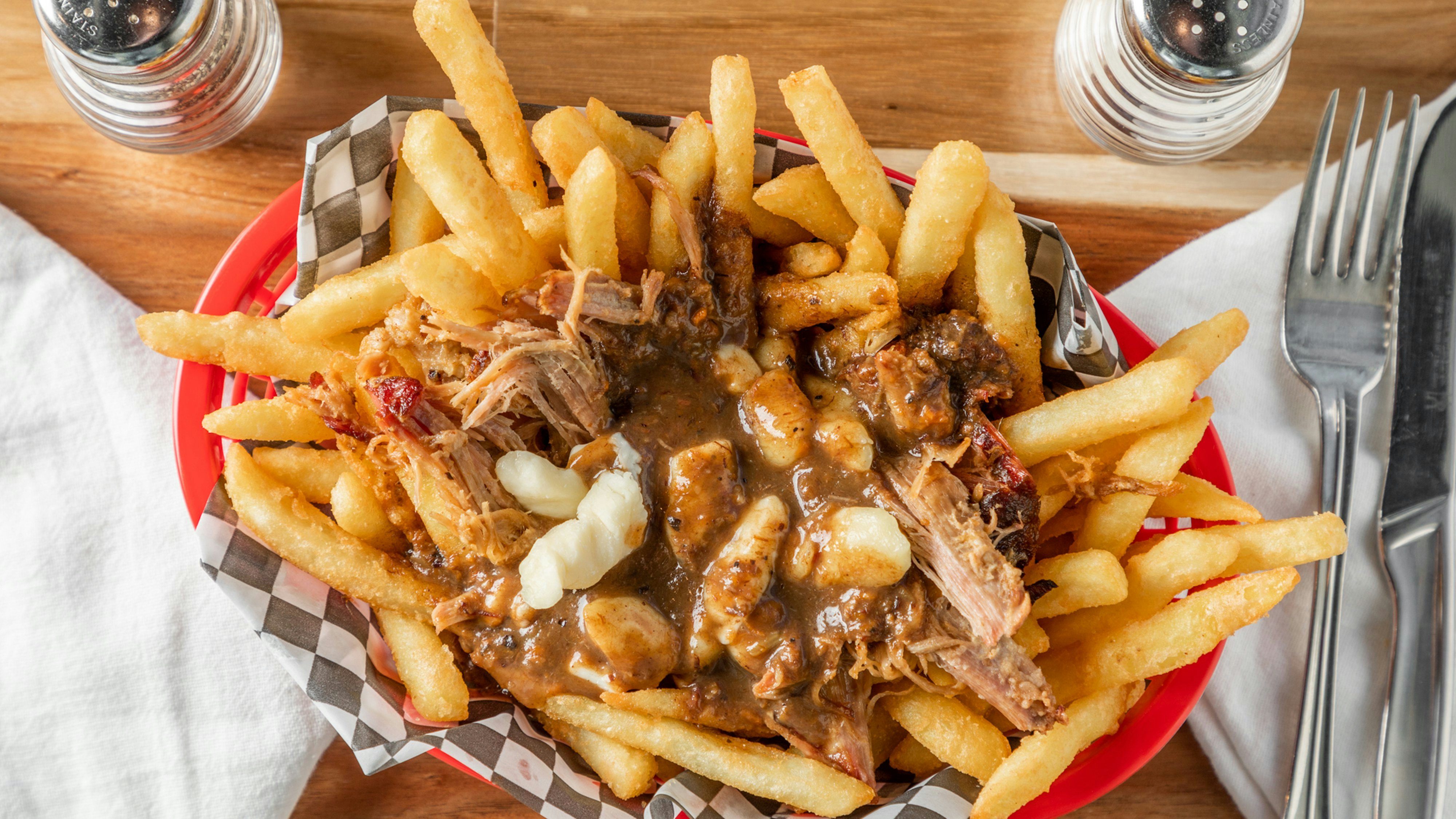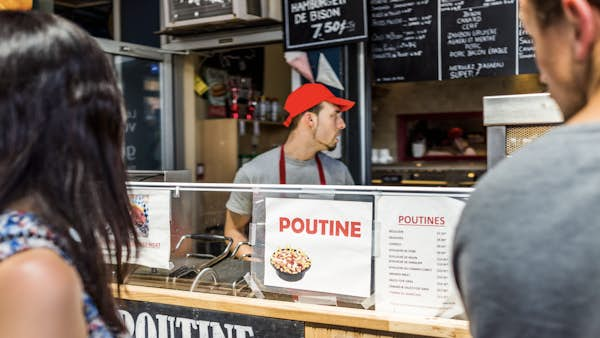Poutine has become a global phenomenon, today appearing on the menus of restaurants and food trucks around the world. Yet the dish will forever be associated with Québec, the Canadian province where it originated.
The now-iconic dish features twice-fried fries topped with fresh, squeaky cheese curds and a thin, spiced gravy – called “brown sauce” or “sauce brune” in French, and made with beef and chicken gravies. Poutine is a popular road-trip snack, an indulgence between last call and bedtime, and a hearty hangover cure. It’s the comfort food that always satisfies.
Here’s all you need to know about poutine – and where to find the best takes on it all over Canada.
Advertisement

A short history of poutine
Poutine originated in the late 1950s, when car culture and casse-croûtes – roadside snack shacks, typically open in the summer and autumn to cater to warm-weather vacationers – were thriving. At the time, french fries were sold in every snack shack in the province, along with steamies (hot dogs) and soft-serve ice cream. Fresh cheese curds were (and still are) sold in snack-sized bags often found piled near cash registers in gas stations, fromageries, casse-croûtes and grocery stores.
As the story goes, the dish was dreamed up by a group of regular customers at a casse-croûte in either Drummondville or Warwick. (Both are on the south shore of the St Lawrence River between Montréal and Québec City, and both places claim to be the birthplace of the dish.) The group asked for a bag of cheese curds to be added to their fries and sauce…and voilà. Soon, this pouding (Québec slang for “a messy mixture”) became known as poutine. The hearty dish quickly won the hearts (and stomachs) of everyday Québécois – especially university students across the province.
Somewhere around the 1980s, poutine started showing up in restaurants across Canada and the USA, even appearing on menus at McDonald’s and Burger King. In the early 2000s, chefs took things further, experimenting with deluxe toppings like lobster, foie gras and even caviar – and attracting the attention of those who had previously dismissed poutine as a messy dish for students and the working class.
These days, the La Poutine Week festival, which began in Montréal in 2013 (on the heels of the very successful Le Burger Week), celebrates poutine by inviting restaurants in cities across Canada (Montréal and Québec City, naturally, but also Toronto, Ottawa, Winnipeg, Calgary and Vancouver) to create over-the-top-gourmet poutines. There’s an app to see which restaurants are participating; you can also rate the poutines you’ve eaten.

The essential ingredients in poutine
French fries form the backbone of every poutine. The best ones are twice-fried, which makes them a little crispy outside but soft inside. Poutine fries should always retain their shape when covered with gravy. Be aware that poutine is usually served piping hot – so take care and wait until the dish cools a bit to avoid burning your mouth with the first bite.
Varying fry shapes (including shoestrings, wedges and chunky hash-brown styles), gourmet toppings and different sauces add variety. But fresh, squeaky cheese curds are essential; this component is not the place for poutine experimentation.
Cheese is made by curdling milk, which separates into liquid whey and small pieces of fresh, solid cheese. These fresh cheese curds can rest unrefrigerated for around 48 hours (they usually have a “refrigerate by” date on them, and total shelf life of about 30 days), and their low acidity keeps them from melting.
Melted cheese on poutine is kind of a clumpy mess; poutine eaters will tell you that the ideal is to easily fork a cheese curd in the same bite as the fries and sauce (and any other toppings). Cheese curds that have been refrigerated change in consistency, melt easily (especially when you put hot gravy on them) and lose that special squeak. It’s just not the same.
Advertisement
Granted, if it’s midnight and you’ve been out drinking beer, you might not be too picky about the state of your curds.

How to order poutine
An important note to begin with: in Québec, it’s pronounced “poo-TEEN,” with a voiced rather than nasal N sound. (The similar-sounding word putain, which does have a nasal ending, is a slang term for prostitute…and worse.)
Ordering poutine at a casse-croûte is straightforward.
Step 1: Choose your toppings. Traditional poutine consists of cheese curds, fries and gravy. From this base, you might add such additional toppings as bacon, hot-dog pieces, smoked meat, chicken with peas, ground beef with onions…or even an or “all dressed” (pepperoni with green peppers and mushrooms). You’ll occasionally find lobster poutine with lobster-bisque gravy, or versions topped with red-wine-braised beef. You can sometimes upgrade with extra cheese curds.
Step 2: Choose a size. Casse-croûtes offer poutine in bébé or mini (extra small), petit (small), moyen (medium) and grande (large) sizes. Sometimes you can order méga or famille (extra large and family) portions.
Step 3: Grab a seat and listen for your name or number. The best casse-croûtes are the busiest ones – you’ll see a crowd massed out front if you’re driving by – so while one person orders and waits for the food, the others can look for a place to sit. Most places have plenty of picnic tables; sitting on the grass, a curb or in a car is fine, too.
If you’re at a diner or a restaurant, poutine usually comes as an appetizer (entrée in French) or main (plat). Toppings and sauces vary to match the theme of the poutine: Indian curry, meaty Bolognese, lobster bisque, barbecue sauce and hollandaise, to name a few.

The best places for poutine in Montreal
La Banquise: A Montréal staple since 1969, La Banquise serves quirky poutines 24 hours a day, with options for vegetarians and vegans.
Chez Tousignant: In Little Italy near Marché Jean-Talon, Chez Tousignant makes fries that are perfect for poutine – which go well with the smashburgers and steamies (hot dogs). Simple and delicious.
Greenspot Restaurant: Serving classic diner fare since 1947, Greenspot is a neighborhood hot spot with over two dozen poutines that you can enjoy from 5am to 11pm.
The best places for poutine in Québec City

Buffet de l’Antiquaire: The breakfast poutine (la cochonne) at Buffet de l’Antiquaire is the best hangover cure you can find: bacon, ham, sausage, onions and green peppers covered with hollandaise and topped with a fried egg.
Chez Gaston: Served in round aluminum containers for easy takeout (though you can also dine in), the poutine is always hot and delicious at Chez Gaston, a local obsession in the St-Roch neighbourhood. Enjoy your poutine at the counter, eat it in a nearby park or simply sit down on a curb. Poutine can be enjoyed anywhere.
Le Chic Shack: Gourmet poutine is on the menu at Le Chic Shack in Vieux-Québec, where the fries are chunky and the flavor combinations are intriguing. La Masala, with Indian curry sauce, chutney and green chilies and cilantro, is only available in summer; the Sugar Shack is a nod to classic Québec flavors, with maple-whisky gravy, cheese curds and crumbled maple bacon. Vegan poutine is also available.

The best places for poutine in the rest of Canada
Le Roy Jucep: In Québec, Drummondville’s Le Roy Jucep trademarked itself as “L’inventeur de la poutine” (though the claim is far from clear). This brightly colored, 1950s-style diner has been serving poutine for over 60 years. Try the “original” poutine, with the cheese curds on the bottom.
Chez Mag: A viral TikTok turned Chez Mag, a local haunt on Île d’Orléans, an island not a short distance from Québec City, into the busiest casse-croûte in the region. Lobster poutine is the top choice here.
The Great Canadian Poutinerie: Ottawa’s The Great Canadian Poutinerie has crispy fries, fresh cheese curds and some crazy poutine combinations – like grilled cheese, hot honey chicken and “B-mac” (think a Big Mac…but make it it poutine: ground beef, onions, melted cheese, pickles and burger sauce).
NomNomNom Poutine: Near Bathurst and Dundas St W in Toronto, look for a Québec flag, which marks NomNomNom Poutine. The classic poutine is good here, as is the jerk-chicken version.
Big T’s Smokehouse: The smoked poutine at Big T’s Smokehouse in Calgary comes topped with juicy smokehouse brisket. A BBQ lover’s dream – and even more delicious when accompanied by fried dill pickles with horseradish mayo.
La Belle Patate: In Vancouver, La Belle Patate serves authentic Québécois comfort foods, including smoked-meat steamies and poutine topped with fresh, squeaky cheese curds.

